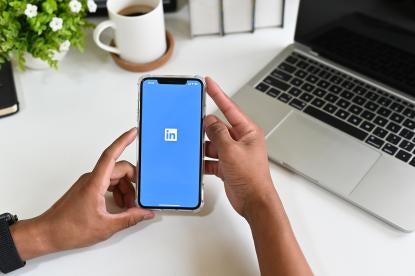LinkedIn is no longer just an online portal for job seekers; it’s a hub for professionals to connect, collaborate and share their expertise. But how do you ensure your content shines bright amidst the competition? In this article, I’ll explore the intricacies of the LinkedIn algorithm and how to use it to your advantage to achieve maximum visibility for your posts.
The Essence of LinkedIn
While many misconstrue LinkedIn as merely a job board, it’s far more than that. It’s a networking powerhouse where professionals find contacts, expand their brands and share their business stories.
While other social platforms may have seen stagnant growth, LinkedIn continues to flourish. It has evolved, transitioning from being a repository of corporate content to a platform where users confidently share personal tales and insights.
The power of LinkedIn lies in its trustworthiness. Most content is anchored with credible data, making it a reliable source of information.
Common Pitfalls on LinkedIn
Why aren’t all LinkedIn aficionados thriving entrepreneurs? Let’s explore some frequent missteps:
- Generalizing Social Media Strategy: LinkedIn isn’t Facebook or Instagram. Its algorithm is unique, prioritizing relationship-building over corporate broadcasts. Your content should resonate, be genuine and human-centric.
- Misaligned Goals: Chase brand awareness, not just leads. Given that a meager 2% of LinkedIn posts are from organic company content, it’s pivotal to prioritize awareness, letting the sales team follow up.
Demystifying the LinkedIn Algorithm
LinkedIn’s emphasis is on the quality of interactions, not just volume. The user base comprises:
- Power users: Those who post at least monthly but often much more than that.
- Content creators: Individuals who post at least once quarterly.
- Content ambassadors: Active engagers but passive posters.
- The silent community: Passive consumers of content.
The silent users on LinkedIn are the vast majority. They scroll through the feed and consume your content, but choose not to interact with it. It takes long-term, consistent posting to convert them into active leads or followers.
The algorithm weighs factors like dwell time, initial post engagement and user behavior, both positive and negative. While dwell time gauges user engagement duration, early post performance analyzes initial reception to decide broader visibility.
LinkedIn also factors in negative engagement indicators to enhance its data analysis. These are signals that people are choosing to ignore or navigate away from your content such as pausing a video, unfollowing you or untagging themselves from a post. These will all downgrade your post and negatively affect the visibility of your content.
Dwell Time
Dwell time is a vital measure on LinkedIn. It gauges the duration a user dedicates to viewing your content or the amount of time it remains visible on their screen. Do they pause their scrolling? Do they fully engage with a post or view an entire video?
LinkedIn’s design is inherently geared towards maximizing dwell time. As an illustration, LinkedIn initially displays just the beginning lines of a post, followed by a “See More” link. This approach is specifically tailored to gather relevant data from the passive users for its algorithm.
To enhance your LinkedIn performance, focus on crafting posts that encourage extended dwell time. Endeavor to compose more extended posts that span at least eight lines. Incorporating additional lines and spaces in your content can further amplify this effect.
Initial Post Performance
Upon clicking “Publish” on a LinkedIn post, the content isn’t broadcasted to a random audience. The LinkedIn algorithm employs a distinct method to evaluate its efficacy and prospective dissemination.
During the initial 60-90 minutes post-publication, LinkedIn scrutinizes your newly shared post among the core members of your network, roughly equivalent to 7% of your entire followers. These individuals are those who consistently engage with and appreciate your most outstanding content.
If this central group of users positively engages with your content, the algorithm broadens its reach. Conversely, if they display a lack of interest, the content’s visibility diminishes.
Use of Links in Posts
One pivotal factor in your LinkedIn success is the management of links. External links in your posts could stifle your reach by up to 50%. To navigate this:
- Share links only if they’re paramount to conversions.
- Otherwise, add links in the comments of your post, guiding users there.
Exercise caution when incorporating a call to action in LinkedIn posts. A few months back, LinkedIn indicated that posts explicitly soliciting engagement would be adversely affected by its algorithm. Requesting shares, likes, or prompting users to comment specific phrases could lead to diminished visibility of your post in the feed.
Personal vs. Company Profiles
While the algorithm behaves similarly across profiles, personal ones have an advantage. Immediate responses to comments can amplify your content’s reach. Engaging with others’ content can also bolster your profile’s visibility.
For company pages, the approach leans towards consistency and quality, as immediate engagement might not be as impactful.
Six Highly Effective Content Types for LinkedIn
- Personal Narratives: Tales told from personal experiences resonate deeply on LinkedIn. Audiences appreciate authentic insights into a brand’s evolution and its driving forces.
- Expert Opinions: Disseminating expert knowledge helps cement your position as a thought leader. While these posts might primarily captivate the less vocal LinkedIn members, consistent quality will ultimately lead to tangible results.
- Event Spotlights: Share your participation in events – whether you’re a guest, host or speaker. Providing updates pre-event, live and post-event can elevate your content’s interaction, especially with other event attendees.
- User Contributions: While user-generated content (UGC) is often associated with B2C sectors on platforms like Instagram, it’s invaluable everywhere. Celebrate your brand by showcasing client success stories, testimonials and interviews.
- Curated Insights: Not every post requires original content. Positioning yourself as a content aggregator helps fortify your authority. However, personal profiles are better suited for this than business pages to avoid unintentionally promoting competitors.
- Celebrating Your Team: Highlighting your team’s achievements and perspectives is pivotal. It not only provides a human touch to your brand but also underlines your company ethos. As a recruitment strategy in a tight job market, spotlighting satisfied and involved employees gives businesses an edge.
In Conclusion
Understanding the LinkedIn algorithm isn’t about exploiting loopholes; it’s about fostering genuine connections and sharing valuable content. Align your actions with this philosophy, and you’ll amplify your presence on this dynamic platform.
Crafting LinkedIn-Friendly Content
Here’s a roadmap to create content preferred by the LinkedIn algorithm.
- Narratives: Share your brand’s story or personal journey.
- Expert Insights: Build your reputation with insightful posts. Though engagement might be subtle, consistency will yield results.
- Events: Chronicle events at which you’re speaking, attending and/or sponsoring, leveraging the collective engagement.
- User Contributions: Use testimonials, case studies, success stories and the like.
- Third-Party Content: Occasionally, curate and share high-quality content relevant to your audience.
- Employee Engagement: Promote posts from your employees, showcasing company culture.




 i
i


